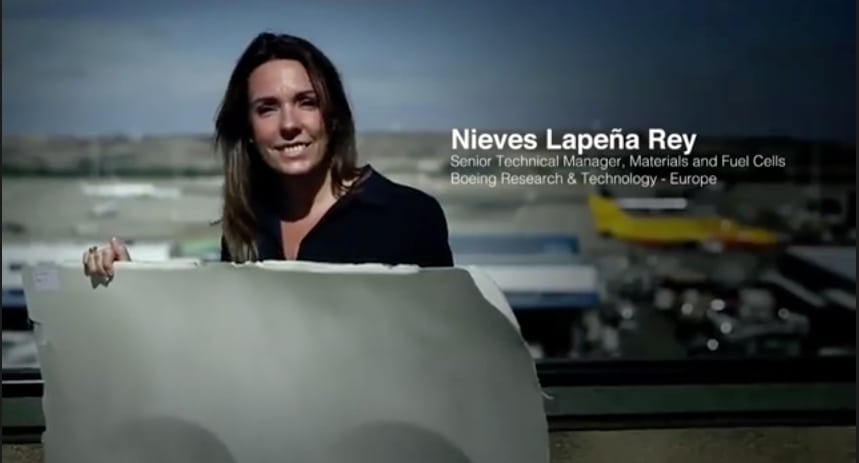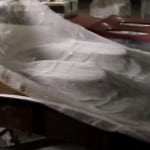Skift Take
As the aircraft interiors market keeps growing, manufacturers growing their own sustainable components makes sense.
- Boeing technicians drape flax fabric over mold to form cabin wall panels.
- Boeing Senior Technical Manager, Nieves Lapeña Rey, holds Boeing’s flax-based sustainable cabin wall panel.
We celebrate when airlines reveal new cabin fashions, but all those pretty interiors are hiding a dirty little secret: Their environmental impact.
The race for the space inside the fuselage is heated, with the aircraft interiors market at a historic high, estimated to reach $12 billion by 2016 with a compound annual growth rate of 8%, according to a report by Aircraft Interiors International Magazine. New interiors installed mean old interiors tossed out, and, as the interiors arms race escalates, the life cycle of those programs is also predicted to shorten. More frequent new programs mean even more interiors components destined for the heap.
To put the numbers in perspective, the Aircraft Fleet Recycling Association estimates that the aircraft dismantling market will reach $80 million this year, and projects that this market will continue to grow. The organization refers to this trend as an “aircraft retirement Tsunami” which will hit the industry by 2023, with 1,000 aircraft per year retired from service. Many aircraft interiors components are tossed out, even before the aircraft is removed from service, aggravating the problem.
But Boeing may have grown an ideal solution in the fields of Spain.
The aircraft manufacturer is creating sustainable aircraft interiors wall panels using a simple sustainable material: flax. A Boeing Engineering Team based near Madrid put these future eco-friendly interiors components through rigorous aviation testing.
The sturdy fibers of flax have long been used in the production of fabrics. But flax has never before been tried in the production of composites which could be formed into aircraft cabin walls, seat shells, and other cabin decorative elements currently composed of plastics or glass-fiber composites.
“We are working with materials that are totally novel. There is nothing written about them,” says Nieves Lapeña Rey, Senior Technical Manager, Materials and Fuel Cells at Boeing Research and Technology, Europe. “We have to engineer them and tailor their properties. We’re trying to develop materials that offer similar performance [to existing interiors components] but have an environmental advantage.”
The flax fibers are formed into a textile which is specially treated with non-halogenated flame retardants. This treatment addresses the biggest problem for any aircraft interiors introductions: the stringent requirements of flammability testing. The flame-treated flax fabric is then impregnated by a resin to form the skin of the panels.
Boeing places emphasis on the readily available supply of raw-materials for these products.
“There is good flax everywhere, but in Europe there is consistency of the supply,” says Lapeña Rey. “Our goal is to test the sustainable panels. If the tests are successful we will be looking at implementing them into the aircraft in the near future.”
Not all aircraft interiors end up in landfills. A strong aircraft interiors after-market purchases used interiors from airlines, restores them to like-new condition and then resells these refreshed interiors to airlines which would not equip their cabins with factory-new items. While this market has always been good, supply may soon exceed demand.
Airlines and the aircraft interiors industry have searched for alternative solutions to the by-products of this new-image frenzy for years. Some notable programs, including Southwest Airlines’ recyclable carpets, have taken flight.
The newly-founded AIRA (Aircraft Interior Recycling Association) is a project initiated Tony Seville, an aircraft interiors industry veteran of 30 years, based in the UK, who has developed methodologies for recycling nearly 100% of the by-products of used aircraft interiors.
Jennifer Coutts Clay, author of Jetliner Cabins and herself a veteran of the aviation industry since 1979 (the first woman named as Head of Operations and Sales for Western US at British Airways) has long been a proponent for sustainable aircraft interiors solutions. In a comprehensive White-Paper, Green Horizons, she details ongoing airline green cabin initiatives and the opportunities which the industry has to further these programs.
“For manufacturers currently developing high-tech cabin products,” she has told Aircraft Interiors International Magazine, “there will be a huge range of opportunities—both for new aircraft and retrofits.”
The Daily Newsletter
Our daily coverage of the global travel industry. Written by editors and analysts from across Skift’s brands.
Have a confidential tip for Skift? Get in touch
Tags: Boeing
Photo credit: Still from a promotional film by Boeing. Boeing


